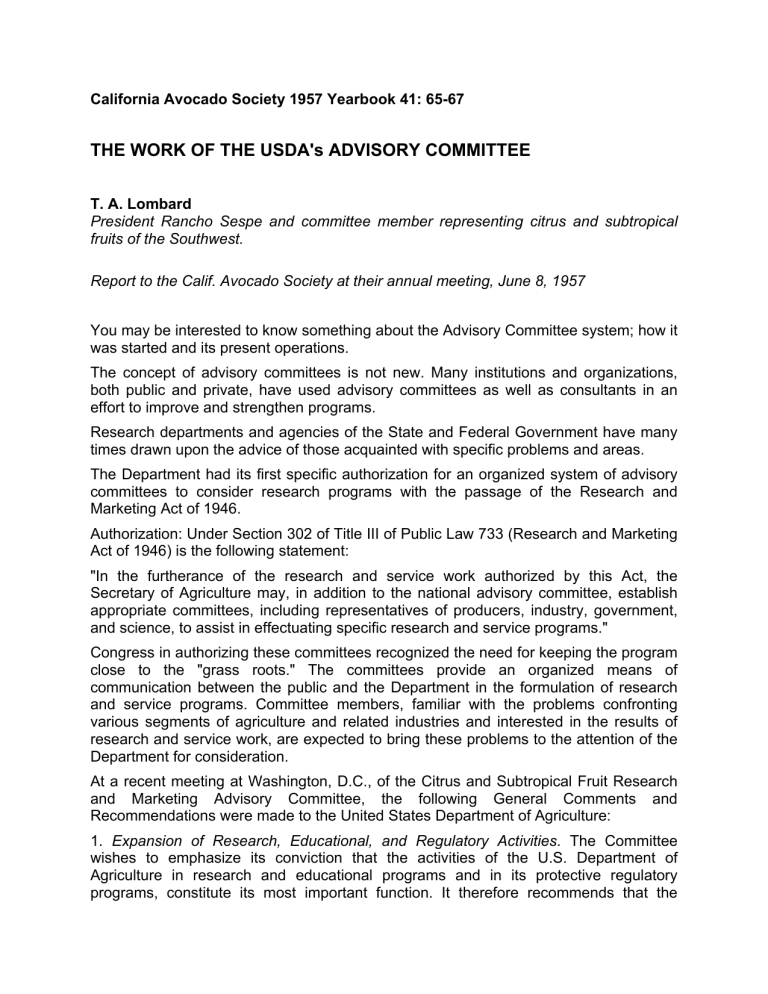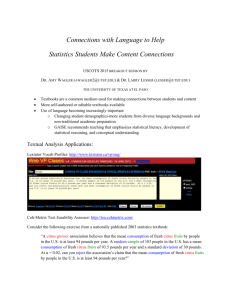THE WORK OF THE USDA's ADVISORY COMMITTEE

California Avocado Society 1957 Yearbook 41: 65-67
THE WORK OF THE USDA's ADVISORY COMMITTEE
T. A. Lombard
President Rancho Sespe and committee member representing citrus and subtropical fruits of the Southwest.
Report to the Calif. Avocado Society at their annual meeting, June 8, 1957
You may be interested to know something about the Advisory Committee system; how it was started and its present operations.
The concept of advisory committees is not new. Many institutions and organizations, both public and private, have used advisory committees as well as consultants in an effort to improve and strengthen programs.
Research departments and agencies of the State and Federal Government have many times drawn upon the advice of those acquainted with specific problems and areas.
The Department had its first specific authorization for an organized system of advisory committees to consider research programs with the passage of the Research and
Marketing Act of 1946.
Authorization: Under Section 302 of Title III of Public Law 733 (Research and Marketing
Act of 1946) is the following statement:
"In the furtherance of the research and service work authorized by this Act, the
Secretary of Agriculture may, in addition to the national advisory committee, establish appropriate committees, including representatives of producers, industry, government, and science, to assist in effectuating specific research and service programs."
Congress in authorizing these committees recognized the need for keeping the program close to the "grass roots." The committees provide an organized means of communication between the public and the Department in the formulation of research and service programs. Committee members, familiar with the problems confronting various segments of agriculture and related industries and interested in the results of research and service work, are expected to bring these problems to the attention of the
Department for consideration.
At a recent meeting at Washington, D.C., of the Citrus and Subtropical Fruit Research and Marketing Advisory Committee, the following General Comments and
Recommendations were made to the United States Department of Agriculture:
1. Expansion of Research, Educational, and Regulatory Activities . The Committee wishes to emphasize its conviction that the activities of the U.S. Department of
Agriculture in research and educational programs and in its protective regulatory programs, constitute its most important function. It therefore recommends that the
Department give these activities the highest priority and urges the Congress to implement fully the original, long-term concept of the Research and Marketing Act of
1946 of systematically increasing the funds for these kinds of work.
2. Basic Research . The Committee emphasized the essentiality of basic research in all the sciences applicable to the solution of agricultural problems. It feels that the solution of our present and future problems will depend upon the results of basic research and therefore increased attention and support should be given to an enlarging program of basic or fundamental research.
3 . Utilization Research . The Committee strongly favors increased financial support for utilization research relating to the industrial utilization of agricultural products. It likewise is greatly convinced that such increased support should be channeled directly through existing research and educational institutions. These are best qualified to direct and implement the objectives now under consideration on this subject by the President's
Bipartisan Commission on Increased Industrial Use of Agricultural Products.
4. Scientific Manpower Problems . The Committee reiterates its concern over the shortage of scientists, and the resultant increased competition for scientific personnel in research, instructional, and service activities. It feels every effort should be made to interest our youth in scientific careers. It commends the Department's program of employing high school and college students for summer and part-time jobs in its various laboratories. Governmental agencies, industry, and foundations should continue all possible aids to the solution of this increasingly serious problem.
5. Successful Cooperation . The Committee, in its review of the current program and proposals for future activation, notes with satisfaction the cooperation being achieved between various agencies within the Department and with the State experiment stations. This attitude assures the best team approach in the solution of our complex problems.
6. Inspection at Ports of Entry . The Committee commends the Government for its increased efforts in the inspection at ports of entry in order to safeguard our agriculture through prevention of introduction of injurious insects and diseases. The Committee feels, however, the program must be increased in order to provide a complete aroundthe-clock inspection at all ports of entry.
7. Insect Control Campaigns . The Committee praised the expeditious manner in which the Medfly infestation in Florida has been handled, and urge that all agencies should prosecute vigorously the program of inspection and eradication to a successful completion. The Committee likewise is gratified with the plant pest control activities of the Department in Mexico and Hawaii.
8. Additional Research Facilities for California . The Committee again recommends the expansion of facilities of the Fruit and Vegetable Chemistry Laboratory at Pasadena by the construction of three new laboratories in the existing pilot plant area within the present building. This conversion of space use is necessary to meet the recommendations of advisory committees for a change in the research program from applied pilot plant studies to more basic chemical studies on fruits and vegetables.
Research in three categories was considered. Among proposals receiving priority in
each category were the following:
PRODUCTION RESEARCH : Initiate research to develop and improve equipment and methods for the mechanization of harvesting and farm-handling citrus crops. Expand studies to breed better citrus varieties and rootstocks. Increase work on "spreading decline," a threat to Florida citrus growers, caused mainly by the burrowing nematode.
UTILIZATION AND CONSUMER-USE RESEARCH : Expand composition studies of citrus and subtropical fruits to determine how changes within constituents of plants can lead to losses of quality. Increase and speedup research to improve products from colored and white grapefruit, including studies on the effect of cultural practices on processing and storing products such as juice, concentrates, and sections. Expand investigations to improve objective methods for measuring fruit quality to obtain greater uniformity in quality of processed citrus and subtropical fruit products.
MARKETING RESEARCH : Expand research on the cause and control of post-harvest diseases of citrus and other subtropical fruits such as avocados, mangoes, and dates.
Increase studies to develop objective methods for measuring quality and maturity for use in grading and inspecting fresh and processed citrus products. Expand studies to provide the best temperatures for citrus and other subtropical fruits and their products transported by truck, rail, and ship.
Under domestic marketing services of USDA, the committee called for expanded work on development and revision of U.S. grade standards for citrus fruits and products; obtain market news reports from more cities on truck receipts; expand work on planning wholesale food marketing facilities in specific localities. The group also urged a continuation of USDA's foreign market development program for citrus fruits and products.
The committee called for an expansion of cooperative service work by State departments of agriculture to improve or maintain quality control and to widen outlets for citrus fruits and products. It endorsed an expanded program by the Cooperative
Extension Service of educational work with citrus producers, wholesalers, retailers, and consumers.



